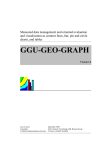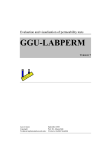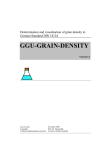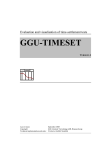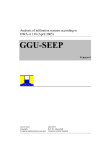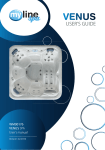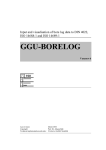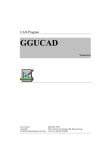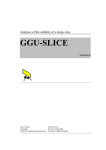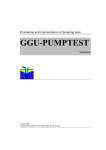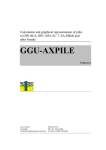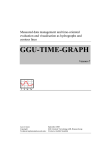Download GGU-ATTERBERG - Index of
Transcript
Evaluation and visualisation of plastic and liquid
limits to German Standard DIN 18122 (Part 1)
GGU-ATTERBERG
VERSION 5
Last revision:
January 2011
Copyright:
Prof. Dr. Johann Buß
Technical implementation and sales: Civilserve GmbH, Steinfeld
Contents:
1 Preface .................................................................................................................................. 4
2 Licence protection and installation .................................................................................... 4
3 Language selection............................................................................................................... 5
4 Starting the program ........................................................................................................... 5
5 Description of menu items................................................................................................... 6
5.1 File menu.......................................................................................................................... 6
5.1.1 "New" menu item..................................................................................................... 6
5.1.2 "Load" menu item .................................................................................................... 6
5.1.3 "Save" menu item .................................................................................................... 6
5.1.4 "Save as" menu item ................................................................................................ 6
5.1.5 "Print 'simple' output table" menu item.................................................................... 7
5.1.6 "Export to ASCII" menu item.................................................................................. 7
5.1.7 "Printer preferences" menu item .............................................................................. 7
5.1.8 "Print and export" menu item .................................................................................. 8
5.1.9 "Batch print" menu item ........................................................................................ 10
5.1.10 "Exit" menu item.................................................................................................... 10
5.1.11 "1, 2, 3, 4" menu items........................................................................................... 10
5.2 Edit menu ....................................................................................................................... 11
5.2.1 "Base data" menu item........................................................................................... 11
5.2.2 "Tests" menu item.................................................................................................. 12
5.2.3 "Delete all tests" menu item................................................................................... 15
5.2.4 "Test data input via editor" menu item .................................................................. 15
5.2.5 "General" menu item.............................................................................................. 16
5.2.6 "Company" menu item........................................................................................... 16
5.2.7 "Container database" menu item............................................................................ 17
5.3 Graphics preferences menu ............................................................................................ 18
5.3.1 "Preferences" menu item........................................................................................ 18
5.3.2 "Refresh and zoom" menu item ............................................................................. 18
5.3.3 "Zoom info" menu item ......................................................................................... 19
5.3.4 "Legend font selection" menu item........................................................................ 19
5.3.5 "Font size selection" menu item............................................................................. 19
5.3.6 "Mini-CAD toolbar" menu item ............................................................................ 19
5.3.7 "Toolbar preferences" menu item .......................................................................... 19
5.3.8 "Load graphics preferences" menu item ................................................................ 20
5.3.9 "Save graphics preferences" menu item................................................................. 20
5.4 Output preferences menu ............................................................................................... 21
5.4.1 General note........................................................................................................... 21
5.4.2 "Page size" menu item ........................................................................................... 21
5.4.3 "Texts" menu item ................................................................................................. 22
5.4.4 "Margins" menu item............................................................................................. 22
5.4.5 "Position info" menu item...................................................................................... 23
5.4.6 "Title (change position)" menu item...................................................................... 23
5.4.7 "Plasticity diagram" menu item ............................................................................. 23
5.4.8 "Company" menu item........................................................................................... 23
GGU-ATTERBERG User Manual
Page 2 of 30
January 2011
5.4.9 "Test no., etc." menu item...................................................................................... 24
5.4.10 "Annex and report" menu item .............................................................................. 24
5.4.11 "Plasticity range" menu item.................................................................................. 24
5.4.12 "Blow diagram" menu item.................................................................................... 24
5.4.13 "Consistency" menu item....................................................................................... 24
5.4.14 "Water content etc." menu item ............................................................................. 24
5.4.15 "Table" menu item ................................................................................................. 25
5.4.16 "Reset all" menu item ............................................................................................ 25
5.4.17 "Move objects" menu item..................................................................................... 25
5.5 ? menu ............................................................................................................................ 26
5.5.1 "Copyright" menu item .......................................................................................... 26
5.5.2 "Maxima" menu item ............................................................................................. 26
5.5.3 "Help" menu item .................................................................................................. 26
5.5.4 "GGU on the web" menu item ............................................................................... 26
5.5.5 "GGU support" menu item..................................................................................... 26
5.5.6 "What's new?" menu item...................................................................................... 26
5.5.7 "Language preferences" menu item ....................................................................... 26
6 Tips and tricks.................................................................................................................... 27
6.1 Keyboard and mouse...................................................................................................... 27
6.2 Function keys ................................................................................................................. 27
6.3 "Copy/print area" icon.................................................................................................... 28
7 Index.................................................................................................................................... 29
GGU-ATTERBERG User Manual
Page 3 of 30
January 2011
1 Preface
The GGU-ATTERBERG program allows evaluation and visualisation of tests to determine consistency limits to DIN 18122 (Part 1). Select between DIN, ASTM and British Standard (BS
5930:1999) for visualisation of the plasticity diagram.
Data input is in accordance with conventional WINDOWS operations and can therefore be learned
almost entirely without the use of a manual. Graphic output supports the true-type fonts supplied
with WINDOWS, so that excellent layout is guaranteed. Colour output and any graphics (e.g. files
in formats BMP, JPG, PSP, TIF, etc.) are supported. DXF files can also be imported by means of
the integrated Mini-CAD module (see the "Mini-CAD" manual).
The program has been thoroughly tested. No faults have been found. Nevertheless, liability for
completeness and correctness of the program and the manual, and for any damage resulting from
incompleteness or incorrectness, cannot be accepted.
2 Licence protection and installation
In order to guarantee a high degree of quality, a hardware-based copy protection system is used
for the GGU-ATTERBERG program.
The GGU software protected by the CodeMeter copy protection system is only available in
conjunction with the CodeMeter stick copy protection component (hardware for connection to the
PC, "CM stick"). Because of the way the system is configured, the protected software can only be
operated with the corresponding CM stick. This creates a fixed link between the software licence
and the CM stick copy protection hardware; the licence as such is thus represented by the CM
stick. The correct Runtime Kit for the CodeMeter stick must be installed on your PC.
Upon start-up and during running, the GGU-ATTERBERG program checks that a CM stick is
connected. If it has been removed, the program can no longer be executed.
For installation of GGU software and the CodeMeter software please refer to the information in
the Installation notes for GGU Software International, which are supplied with the program.
GGU-ATTERBERG User Manual
Page 4 of 30
January 2011
3 Language selection
GGU-ATTERBERG is a bilingual program. The program always starts with the language setting
applicable when it was last ended.
The language preferences can be changed at any time in the "?" menu, using the menu item
"Spracheinstellung" (for German) or "Language preferences" (for English).
4 Starting the program
After starting the program, you will see two menus at the top of the window:
• File
• ?
After clicking on the "File" menu, a previously entered test can be loaded by means of the "Load"
menu item, or a new one created using "New". An example from DIN 18122 is saved as a file
("ATTERBER-e.ztd") on the disk. The DIN example is, unfortunately, erroneous. The file contains the corrected version.
After clicking on "File/New" an empty form in accordance with German Standard DIN 18122 is
shown on the screen. Five menus now appear at the top of the window:
• File
• Edit
• Graphics preferences
• Output preferences
• ?
After clicking one of these menus, the so-called menu items roll down, allowing you access to all
program functions.
The program works on the principle of What you see is what you get. This means that the screen
presentation represents, overall, what you will see on your printer. In the last consequence, this
would mean that the screen presentation would have to be refreshed after every alteration you
make. For reasons of efficiency and as this can take several seconds for complex screen contents,
the GGU-ATTERBERG screen is not refreshed after every alteration.
If you would like to refresh the screen contents, press either [F2] or [Esc]. The [Esc] key additionally sets the screen presentation back to your current zoom, which has the default value 1.0, corresponding to an A4 format sheet.
GGU-ATTERBERG User Manual
Page 5 of 30
January 2011
5 Description of menu items
5.1
5.1.1
File menu
"New" menu item
All input data will be deleted after a security request. After this, you can enter new tests.
5.1.2
"Load" menu item
You can load a file with test data, which was created and saved at a previous sitting, and then edit
the test data.
5.1.3
"Save" menu item
You can save data entered or edited during program use to a file, in order to have them available at
a later date, or to archive them. The data is saved without prompting with the name of the current
file.
5.1.4
"Save as" menu item
You can save data entered during program use to an existing file or to a new file, i.e. using a new
file name. For reasons of clarity, it makes sense to use ".ztd" as file suffix, as this is the suffix
used in the file requester box for the menu item "File/Load". If you choose not to enter an extension when saving, ".ztd" will be used automatically.
GGU-ATTERBERG User Manual
Page 6 of 30
January 2011
5.1.5
"Print 'simple' output table" menu item
You can have a result output table of the current test data sent to the printer or save it to a file for
further processing using a different program, e.g. a word processing application. You will see the
following dialogue box for specifying the simple table output:
• "Printer preferences" group box
Using the "Edit" button the current printer preferences can be changed or a different printer
selected. Using the "Save" button, all preferences from this dialogue box can be saved to a
file in order to have them available for a later session. If you select "GGUATTERBERG.drk" as file name and save the file in the program folder (default), the file
will be automatically loaded the next time you start the program.
Using the "Page format" button you can define, amongst other things, the size of the left
margin and the number of rows per page. The "Header/footer" button allows you to enter
a header and footer text for each page. If the "#" symbol appears within the text, the current
page number will be entered during printing (e.g. "Page #"). The text size is given in "Pts".
You can also change between "Portrait" and "Landscape" formats.
• "Print pages" group box
If you do not wish pagination to begin with "1" you can add an offset number to the check
box. This offset will be added to the current page number. The output range is defined using "From page no." "to page no.".
• "Output to:" group box
Start output by clicking on "Printer" or "File". The file name can then be selected from or
entered into the box.
5.1.6
"Export to ASCII" menu item
The test data can be exported to an ASCII file, allowing processing in other applications.
5.1.7
"Printer preferences" menu item
You can edit printer preferences (e.g. swap between portrait and landscape) or change the printer
in accordance with WINDOWS conventions.
GGU-ATTERBERG User Manual
Page 7 of 30
January 2011
5.1.8
"Print and export" menu item
You can select your output format in a dialogue box. You have the following possibilities:
• "Printer"
allows graphic output of the current screen contents (graphical representation) to the
WINDOWS default printer or to any other printer selected using the menu item
"File/Printer preferences". But you may also select a different printer in the following
dialogue box by pressing the "Printer prefs./change printer" button.
In the upper group box, the maximum dimensions which the printer can accept are given.
Below this, the dimensions of the image to be printed are given. If the image is larger than
the output format of the printer, the image will be printed to several pages (in the above example, 4). In order to facilitate better re-connection of the images, the possibility of entering an overlap for each page, in x and y direction, is given. Alternatively, you also have the
possibility of selecting a smaller zoom factor, ensuring output to one page ("Fit to page"
button). Following this, you can enlarge to the original format on a copying machine, to ensure true scaling. Furthermore, you may enter the number of copies to be printed.
• "DXF file"
allows output of the graphics to a DXF file. DXF is a common file format for transferring
graphics between a variety of applications.
• "GGUCAD file"
allows output of the graphics to a file, in order to enable further processing with the
GGUCAD program. Compared to output as a DXF file this has the advantage that no loss
of colour quality occurs during export.
GGU-ATTERBERG User Manual
Page 8 of 30
January 2011
• "Clipboard"
The graphics are copied to the WINDOWS clipboard. From there, they can be imported
into other WINDOWS programs for further processing, e.g. into a word processor. In order
to import into any other WINDOWS program you must generally use the "Edit/Paste"
function of the respective application.
• "Metafile"
allows output of the graphics to a file in order to be further processed with third party software. Output is in the standardised EMF format (Enhanced Metafile format). Use of the
Metafile format guarantees the best possible quality when transferring graphics.
If you select the "Copy/print area" tool
from the toolbar, you can copy parts of
the graphics to the clipboard or save them to an EMF file. Alternatively you can send
the marked area directly to your printer (see "Tips and tricks", Section 6.3).
Using the "Mini-CAD" program module you can also import EMF files generated using other GGU applications into your graphics.
• "MiniCAD"
allows export of the graphics to a file in order to enable importing to different GGU applications with the Mini-CAD module.
• "GGUMiniCAD"
allows export of the graphics to a file in order to enable processing in the GGUMiniCAD
program.
• "Cancel"
Printing is cancelled.
GGU-ATTERBERG User Manual
Page 9 of 30
January 2011
5.1.9
"Batch print" menu item
If you would like to print several appendices at once, select this menu item. You will see the following dialogue box:
Create a list of files for printing using "Add" and selecting the desired files. The number of files is
displayed in the dialogue box header. Using "Delete" you can mark and delete selected individual
files from the list. After selecting the "Delete all" button, you can compile a new list. Selection of
the desired printer and printer preferences is achieved by pressing the "Printer" button.
You then start printing by using the "Print" button. In the dialogue box which then appears you
can select further preferences for printer output such as, e.g., the number of copies. These preferences will be applied to all files in the list.
5.1.10
"Exit" menu item
After a confirmation prompt, you can quit the program.
5.1.11
"1, 2, 3, 4" menu items
The "1, 2, 3, 4" menu items show the last four files worked on. By selecting one of these menu
items the listed file will be loaded. If you have saved files in any other folder than the program
folder, you can save yourself the occasionally onerous rummaging through various sub-folders.
GGU-ATTERBERG User Manual
Page 10 of 30
January 2011
5.2
5.2.1
Edit menu
"Base data" menu item
After selecting this menu item the following dialogue box appears:
You can specify whether to use the ÖNORM B 4411 designations on the output sheet. By activating the appropriate check box when evaluating the consistency, evaluation can be performed according to the new EN ISO 14688-2.
Select from various standards for plasticity diagram visualisation using the arrow of the dropdown list. The DIN visualisation is used by default; however, it is also possible to select visualisation according to the requirements of the ASTM (American Society for Testing and Materials). In
addition,visualisation according to the requirements of BS 5930 (British Standard, 1999 edition)
is also possible.
Enter the natural water content of the sample and, if available, the oversize grain component and
its water content (each in %) into the three data boxes.
GGU-ATTERBERG User Manual
Page 11 of 30
January 2011
It is also possible to determine the plastic limit using an empirical equation. If this check box is
activated it is not necessary to enter data for the plastic limit. The plastic limit is then determined
from the liquid limit by means of the given equation. The equation used should be treated with
caution.
If you have determined the plastic limit using a machine, you activate the "Plastic limit determined with machine" check box. Additionally, a machine-dependent corrections "alpha" and
"beta" can be entered.
5.2.2
"Tests" menu item
This point represents the program's central menu item. Almost all the test data are entered here. As
an example, after clicking this menu item the following dialogue box opens:
Seven tests are already present in this example. The tests are automatically numbered and the test
numbers ("1, 2, 3, ...") shown on the respective buttons. The suffix "F" or "P" designates a test for
determination of the liquid (Flow) limit or the plastic (Plastic) limit respectively. The following
actions are possible:
• "To menu bar"
You return to the original menu bar.
• "New"
You will create a new test in order to enter the appropriate data (see below).
• "Show base data"
The test data corresponding to any entered single tests are computed and displayed in an info box. The same data are shown on the output sheet in the "Water content, etc." element
(see Section 5.4.14).
GGU-ATTERBERG User Manual
Page 12 of 30
January 2011
• "Show test data"
The water content data for the tests will be calculated and displayed, together with all input
data, e.g.:
The test data can also be shown on the output sheet in table format if the corresponding
element is activated (see "Output preferences/Table", Section 5.4.15).
• "1F", "2F", ...,"5P", "6P",...
By pressing the appropriate button, you can edit or check the data for a particular test.
If only one individual test is entered for liquid limit determination, the program will evaluate with
the one-point method in accordance with German Standard DIN 18122 . For this, the blow count
must be between 15 and 35. Otherwise an error message will appear. In the blow diagram, only
one value is displayed, without a best-fit line. Additionally, a note is given in the diagram that this
was a one-point test.
The evaluation of the plastic limit is in accordance with the notes in DIN 18122 . This states that
only tests which do not differ in their water content by a maximum of 2% may be evaluated. If,
after this criterion has been applied, less than three tests remain for determination of the plastic
limit, a warning message will be given. For machine determination of the plastic limit, this warning message is suppressed.
After clicking on "New" or on the button of an existing test a dialogue box opens for entering or
editing test data.
GGU-ATTERBERG User Manual
Page 13 of 30
January 2011
The following input or actions can be carried out:
• "Test data" group box
You first enter the number of blows. If you enter a blow count of "0" or a negative value,
this will designate a test for determination of the plastic limit. Otherwise, the following data
will be used for liquid limit determination.
Enter the weights of the sample and the container in the remaining input boxes of the group
box to determine the water content. It is also possible to enter the weight of the test container manually. However, if you use containers with standard weights for your tests it is
recommended to store the weights of the respective containers in a database. This saves repeated input by hand. The database can be stored using the menu item "Edit/Container
database" (see Section 5.2.7). In the place of the input box "Container [g]" an extended
group box is shown in the dialogue box. After activating the "Database" option button the
containers used can be selected from the drop-down combo box.
The container database can also be accessed when using other GGU laboratory programs.
• "Delete test"
The currently displayed test will be deleted.
• "Duplicate test"
The currently displayed test will be duplicated. You will automatically find yourself in the
next test.
• "Show data"
Result data (water content etc.) for the current test will be calculated and displayed in a dialogue box.
• "Done"
You will arrive back at the previous dialogue box. All values entered will be accepted.
GGU-ATTERBERG User Manual
Page 14 of 30
January 2011
5.2.3
"Delete all tests" menu item
After a security request, all tests will be deleted. After this, you can enter a new test using the
"Edit/Tests" menu item (see Section 5.2.2).
5.2.4
"Test data input via editor" menu item
Beside the test data input described above, where the water content is determined by the program,
test data can also be entered directly in an editor. The following dialogue box opens after a confirmation prompt:
First select the "x values to edit" button and enter the number of values to be edited (e.g. "3").
You can then enter the three value pairs (blow count and corresponding water content). Here too,
a blow count of ≤ 0 designates a plastic limit. After selecting the "Done" button, the test results
will be graphically displayed.
The dialogue box shows a maximum of 8 value pairs simultaneously. If more than 8 value pairs
have been entered you can move through the table with the "Forw." and "Back" buttons. Existing
data pairs can be deleted from the end of the list by reducing the number of entries, but a minimum of two data pairs must remain. The data pairs entered using this menu item are deleted following a confirmation prompt when you go to the menu item "Edit/Tests" for a second time.
If only one individual test is entered for liquid limit determination, the program will evaluate with
the one-point method in accordance with German Standard DIN 18122 . For this, the blow count
must be between 15 and 35. Otherwise an error message will appear. In the blow diagram, only
one value is displayed, without a best-fit line. Additionally, a note is given in the diagram that this
was a one-point test.
GGU-ATTERBERG User Manual
Page 15 of 30
January 2011
5.2.5
"General" menu item
Go to this menu item to enter general data such as the project identification, report number, annex
number, etc. This data is displayed in the correct elements of the output sheet.
The marked texts in the dialogue box also appear in the output sheet. Input boxes can be altered or
switched off such as "Test number:" as shown in the above dialogue box by going to the menu
item "Output preferences/Texts" (see Section 5.4.3).
5.2.6
"Company" menu item
You can enter your company address in four lines. These lines will be entered at the top left of the
form.
GGU-ATTERBERG User Manual
Page 16 of 30
January 2011
5.2.7
"Container database" menu item
If you use containers with standard weights for your tests, their weights can be stored in a container database using the dialogue box in this menu item.
Enter the number of containers to be defined via the "x containers to edit" button. The corresponding number of rows for input will then be shown. If more than 8 containers are defined you
can navigate through the list using the "Forw." and "Back" buttons.
If you work with several databases you can save the containers to a database or load a different
database using the appropriate buttons. The database file is first searched for in the program
folder, then at the working level and finally in the Windows folder. It is generally practical to store
the container database in the Windows folder if it is also to be accessed by other GGU laboratory
programs. If the database file is saved using the default name of "GGU-Database.bh_" it is automatically loaded when the program starts. This information is also stored behind the "Info" button.
The containers stored in the database can be accessed in a drop-down combo box in the menu item
"Edit/Tests" (see Page 14).
GGU-ATTERBERG User Manual
Page 17 of 30
January 2011
5.3
5.3.1
Graphics preferences menu
"Preferences" menu item
After selecting this menu item a dialogue box appears, in which you can edit preferences for
graphical visualisation.
Activating the corresponding check boxes you decide whether markers or test numbers are to be
entered at the blow diagram points. If neither of the two check boxes is selected, the values will
not be marked. The marker size is user-defined.
5.3.2
"Refresh and zoom" menu item
The program works on the principle of What you see is what you get. This means that the screen
presentation represents, overall, what you will see on your printer. In the last consequence, this
would mean that the screen presentation would have to be refreshed after every alteration you
make. For reasons of efficiency and as this can take several seconds for complex screen contents,
the screen is not refreshed after every alteration.
If, e.g., after using the zoom function (see below), only part of the image is visible, you can
achieve a complete view using this menu item.
A zoom factor between 0.4 and 8.0 can be entered in the input box. By then clicking on "Use" to
exit the box the current factor is accepted. By clicking on the "0.4", "0.6", etc. buttons, the selected factor is used directly and the dialogue box closed.
It is much simpler, however, to get a complete overview using [Esc]. Pressing [Esc] allows a complete screen presentation using the zoom factor specified in this menu item. The [F2] key allows
screen refreshing without altering the coordinates and zoom factor.
GGU-ATTERBERG User Manual
Page 18 of 30
January 2011
5.3.3
"Zoom info" menu item
By clicking two diametrically opposed points you can enlarge a section of the screen in order to
view details better. An information box provides information on activating the zoom function and
on available options.
5.3.4
"Legend font selection" menu item
With this menu item you can switch to a different true-type font. All available true-type fonts are
displayed in the dialogue box.
5.3.5
"Font size selection" menu item
You can edit font sizes of texts [in mm] within the various input areas.
5.3.6
"Mini-CAD toolbar" menu item
Using this menu item you can add free text to the graphics and add lines, circles, polygons and
images (e.g. files in formats BMP, JPG, PSP, TIF, etc.). A pop-up menu opens; the icons and
functions used are described in more detail in the "Mini-CAD" manual provided.
5.3.7
"Toolbar preferences" menu item
After starting the program a horizontal toolbar for menu items appears below the program menu
bar. If you would rather work with a popup window with several columns, you can specify your
preferences using this menu item. The smarticons can also be switched off.
At the bottom of the program window you find a status bar with further information. You can also
activate or switch off the status bar here. The preferences will be saved in the "GGUATTERBERG.alg" file (see menu item "Graphics preferences/Save graphics preferences")
and will be active at the next time the program is started.
By clicking on the tools (smarticons) you can directly reach most of the program functions. The
meaning of the smarticons appears as a text box if you hover with the mouse pointer over the
tools. Some of the tool functions can be activated from the normal menu items.
"Zoom out"
If you have previously zoomed in, this tool returns to a full screen display.
"Zoom (-)"/"Zoom (+)"
With the zoom functions you can zoom in or out of parts of the image, by clicking the left mouse
button.
"Undo move object"
If you have previously edited the position or size of an element on the output sheet ([F11] or used
"Output preferences/Move objects"), you can undo the last changement with this tool.
"Restore move object"
If you have previously undone a changement, you can restore with this tool.
GGU-ATTERBERG User Manual
Page 19 of 30
January 2011
"Copy/print area"
Use this tool to copy only parts of the graphics in order to paste them, e.g. to a report. You will see
information on this function and can then mark an area, which is copied to the clipboard or can be
saved in a file. Alternatively you can send the marked area directly to your printer (see "Tips and
tricks", Section 6.3).
5.3.8
"Load graphics preferences" menu item
You can reload a graphics preferences file into the program, which was saved using the "Graphics preferences/Save graphics preferences" menu item. Only the corresponding data will be
refreshed.
5.3.9
"Save graphics preferences" menu item
Some of the preferences you made with the menu items of the "Graphics preferences" menu as
well as the inputs using the "Edit/Company" menu item can be saved to a file. If you select
"GGU-ATTERBERG.alg" as file name, and save the file on the same level as the program, the
data will be automatically loaded the next time the program is started and need not be entered
again.
If you do not go to "File/New" upon starting the program, but open a previously saved file
instead, the preferences used at the time of saving are shown. If subsequent changes in the
general preferences are to be used for existing files, these preferences must be imported using the menu item "Graphics preferences/Load graphics preferences".
GGU-ATTERBERG User Manual
Page 20 of 30
January 2011
5.4
5.4.1
Output preferences menu
General note
The DIN 18122 makes no suggestions for presentation of test results. It has become common
practice, however, to use the following presentations:
• Blow diagram;
• Text with test results;
• Consistency;
• Plasticity range;
• Plasticity diagram after Casagrande.
In addition to these elements, which are relevant to test evaluation only, further elements are also
used in the visualisation:
• Title;
• Company;
• Test no., etc.;
• Annex and report;
• Table.
The output sheet can be completely redesigned using the items in this menu.
5.4.2
"Page size" menu item
The default page set-up is A4 (portrait) when the program is started. You can edit the page size in
the dialogue box.
GGU-ATTERBERG User Manual
Page 21 of 30
January 2011
5.4.3
"Texts" menu item
The default labelling of some output sheet elements can be edited in this menu item's dialogue
box. Among other things, the name of the output sheet can be specified here.
Your input in rows 1 to 6 of the above dialogue box, as well as the input for "Report:" and "Annex:" also represent the designations for the input boxes in the "Edit/General" menu item dialogue box. If lines are deactivated in the above dialogue box, the corresponding input boxes in the
"Edit/General" menu item dialogue box are also deactivated (see Section 5.2.5). Use "Reset" to
restore the default labelling settings.
5.4.4
"Margins" menu item
In the default program preferences the form is shown with cutting borders. For output to an A4
printer, a reduction of the printer output is generally necessary, as proprietary printers cannot fully
cover an A4 page. The margin preferences can be defined in the following dialogue box.
By deactivating the "With borders" check box and with an appropriate choice of left and lower
margins, it is generally possible to create a non-reduced printer output. It is necessary to also adapt
the page height and width (see Section 5.4.2).
GGU-ATTERBERG User Manual
Page 22 of 30
January 2011
5.4.5
"Position info" menu item
The positions and layout of the individual elements on the output sheet can be altered using the
following menu items. This menu item provides information on the options for altering the position and layout more quickly using the mouse.
5.4.6
"Title (change position)" menu item
The position and layout of the title element can be altered via the dialogue box for this menu item,
if the "Title display" check box is activated.
The position of the element on the output sheet and its size can be defined or edited by means of
the variables "x" and "y", "dx" and "dy". The element can be provided with a frame and a background colour to suit your personal requirements. If the element needs to be returned to its original
condition, this can be done using the "Reset" button. Alternatively, you can alter the size and
shape of the element using the mouse (see menu item "Output preferences/Move objects", Section 5.4.17).
The heading "Consistency limits" shown in the title element can be edited in the menu item "Output preferences/Texts" (see Section 5.4.3). The texts "Project (1st line)" and "Project (2nd line)"
are entered immediately after double-clicking the element or using the menu item "Edit/General"
(see Section 5.2.5).
5.4.7
"Plasticity diagram" menu item
A dialogue box opens that is almost identical to that for the previous menu item. The same preferences can be specified in this box as in that described in Section 5.4.6. Proceed as described there
to alter the position or layout of the "Plasticity diagram" element.
5.4.8
"Company" menu item
Almost exactly the same dialogue box opens with the same preference options as that described in
the "Output preferences/Title (change position)" menu item (see Section 5.4.6). Simply proceed
as described there to edit the "Company" element.
The input for this element can be edited immediately after double-clicking on the element or via
the menu item "Edit/Company" (see Section 5.2.6).
GGU-ATTERBERG User Manual
Page 23 of 30
January 2011
5.4.9
"Test no., etc." menu item
Almost exactly the same dialogue box opens with the same preference options as that described in
the "Output preferences/Title (change position)" menu item (see Section 5.4.6). To edit the
"Test no., etc.", element, simply proceed as is described there.
The input for this element can be edited immediately after double-clicking on the element or via
the menu item "Edit/General" (see Section 5.2.5). For this element you also have the option of
adapting the texts in front of the input boxes to suit your needs. Go to the menu item "Output
preferences/Texts" (see Section 5.4.3).
5.4.10
"Annex and report" menu item
Almost exactly the same dialogue box opens with the same preference options as that described in
the "Output preferences/Title (change position)" menu item (see Section 5.4.6). To edit the
"Annex and report" element, simply proceed as described there.
The input for this element can be edited immediately after double-clicking on the element or via
the menu item "Edit/General" (see Section 5.2.5). For this element you also have the option of
adapting the texts in front of the input boxes to suit your needs. Go to the menu item "Output
preferences/Texts" (see Section 5.4.3).
5.4.11
"Plasticity range" menu item
Almost exactly the same dialogue box opens with the same preference options as that described in
the "Output preferences/Title (change position)" menu item (see Section 5.4.6). To edit the
"Plasticity range" element, simply proceed asrange described there.
5.4.12
"Blow diagram" menu item
Almost exactly the same dialogue box opens with the same preference options as that described in
the "Output preferences/Title (change position)" menu item (see Section 5.4.6). To edit the
"Blow diagram" element, simply proceed as described there.
5.4.13
"Consistency" menu item
Almost exactly the same dialogue box opens with the same preference options as that described in
the "Output preferences/Title (change position)" menu item (see Section 5.4.6). To edit the
"Consistency" element, simply proceed as described there.
5.4.14
"Water content etc." menu item
Almost exactly the same dialogue box opens with the same preference options as that described in
the "Output preferences/Title (change position)" menu item (see Section 5.4.6). To edit the
"Water content etc." element, simply proceed as described there.
GGU-ATTERBERG User Manual
Page 24 of 30
January 2011
5.4.15
"Table" menu item
This element is hidden in the default program setting. The test and result data of all single tests are
given in the table. Almost exactly the same dialogue box opens with the same preference options
as that described in the "Output preferences/Title (change position)" menu item (see Section
5.4.6). To edit the "Table" element, activate the "Table display" check box.
5.4.16
"Reset all" menu item
With this button, all preferences for the aforementioned elements, which may have been edited
with the previous menu item, will be reset to the program defaults.
5.4.17
"Move objects" menu item
When you go to this item you can move the various objects with the aid of the mouse. Move the
mouse over the object to be moved. When you are located above a moveable object the mouse
pointer appears in the shape of a cross. You can now press and hold the left mouse button and
drag the object to the required position.
After going to this menu item only one object at a time can be moved using the mouse or
its size be altered.
In order to move or edit several objects, this function can be more quickly activated by
pressing [F11] or the
icon.
The size of an object can also be altered using this menu item or the [F11] key. If you move over
the frame of a changeable object after activating this function the mouse assumed the shape of a
double-headed arrow. Hold the left mouse button and move the frame until the object has reached
the required size. To retain the ratio of the sides, pull at one corner only. If on one side only is
pulled the object will become higher or wider.
The last change made in the position or size of an object can be undone using [Back] or by clicking the
icon.
GGU-ATTERBERG User Manual
Page 25 of 30
January 2011
5.5
5.5.1
? menu
"Copyright" menu item
You will see a copyright message and information on the program version number.
The "System" button shows information on your computer configuration and the folders used by
GGU-ATTERBERG.
5.5.2
"Maxima" menu item
You will see information on the default program maxima.
5.5.3
"Help" menu item
The GGU-ATTERBERG help is opened as a PDF document. The help function can also be accessed using the [F1] function key.
5.5.4
"GGU on the web" menu item
Using this menu item you can access the GGU Software website: www.ggu-software.com.
Keep in touch with new program versions and the regular download offers.
If you would like to be automatically notified about program innovations, please register for the
Newsletter in our Knowledge Base. Go to the following website: http://kbase.civilserve.com.
5.5.5
"GGU support" menu item
This menu item takes to the GGU-Software Support area at www.ggu-software.com.
5.5.6
"What's new?" menu item
You will see information on program improvements in comparison to older versions.
5.5.7
"Language preferences" menu item
This menu item allows you to switch the menus and the graphics from German to English and vice
versa. To work in German, deactivate the two check boxes "Dialoge + Menüs übersetzen (translate dialogues, menus)" und "Graphiktexte übersetzen (translate graphics)".
Alternatively, you can work bilingually, e.g. with German dialogue boxes but with graphic output
in English. The program always starts with the language setting applicable when it was last ended.
GGU-ATTERBERG User Manual
Page 26 of 30
January 2011
6 Tips and tricks
6.1
Keyboard and mouse
You can scroll the screen with the keyboard using the cursor keys and the [Page up] and [Page
down] keys. By clicking and pulling with the mouse, with [Ctrl] pressed, you activate the zoom
function, i.e. the selected section will fill the screen. Furthermore you can use the mouse wheel to
zoom in/out or scrolling the screen presentation. The following mouse wheel functions are
available:
• Mouse wheel up
= move screen image up
• Mouse wheel down
= move screen image down
• [Ctrl] + mouse wheel up
= enlarge screen image (zoom in)
• [Ctrl] + mouse wheel down
= shrink screen image (zoom out)
• [Shift] + mouse wheel up
= move screen image right
• [Shift] + mouse wheel down
= move screen image left
If you click the right mouse button anywhere on the screen a context menu containing the principal menu items opens.
By double-clicking the left mouse button on output sheet or Mini-CAD objects, the editor for the
selected object immediately opens, allowing it to be edited. By double-clicking output sheet elements while holding the [Shift] key, the preferences for the position, size and appearance of the
element open for editing in the editor.
6.2
Function keys
Some of the function keys are assigned program functions. The allocations are noted after the
corresponding menu items. The individual function key allocations are:
• [Esc] refreshes the screen contents and sets the screen back to your current zoom, which
has the default value 1.0. This is useful if, for example, you have used the zoom function to
display parts of the screen and would like to quickly return to a complete overview.
• [F1] opens the help file.
• [F2] refreshes the screen without altering the current magnification.
• [F11] activates the menu item "Output preferences/Move objects".
GGU-ATTERBERG User Manual
Page 27 of 30
January 2011
6.3
"Copy/print area" icon
A dialogue box opens when the "Copy/print area" icon
in the menu toolbar is clicked, describing the options available for this function. For example, using this icon it is possible to either
copy areas of the screen graphics and paste them into the report, or send them directly to a printer.
In the dialogue box, first select where the copied area should be transferred to: "Clipboard",
"File" or "Printer". The cursor is displayed as a cross after leaving the dialogue box and, keeping
the left mouse button pressed, the required area may be enclosed. If the marked area does not suit
your requirements, abort the subsequent boxes and restart the function by clicking the icon again.
If "Clipboard" was selected, move to the MS Word document (for example) after marking the
area and paste the copied graphics using "Edit/Paste".
If "File" was selected, the following dialogue box opens once the area has been defined:
The default location of the file is the folder from which the program is started and, if several files
are created, the file is given the file name "Image0.emf" with sequential numbering. If the
"Rename" button in the dialogue box is clicked, a file selector box opens and the copied area can
be saved under a different name in a user-defined folder. Saving can be aborted by pressing the
"Delete" button.
If the "Printer" button was pressed in the first dialogue box, a dialogue box for defining the printer settings opens after marking the area. Following this, a dialogue box for defining the image
output settings opens. After confirming the settings the defined area is output to the selected printer.
GGU-ATTERBERG User Manual
Page 28 of 30
January 2011
7 Index
A
K
American Society for Testing and Materials .... 11
Annex number, edit element............................. 24
Annex number, enter ........................................ 16
ASCII, export file ............................................... 7
ASTM, select for plasticity diagram................. 11
Knowledge Base, access................................... 26
B
Blow diagram, edit element.............................. 24
Blow diagram, preferences of measure point
presentation .................................................. 18
Borders, turn on/off .......................................... 22
British Standard ................................................ 11
BS 5930, select for plasticity diagram.............. 11
C
Clipboard ............................................................ 9
CodeMeter stick.................................................. 4
Company, edit element ..................................... 23
Company, enter address.................................... 16
Consistency, edit element ................................. 24
Consistency, evaluate to EN ISO 14688-2 ....... 11
Container database, edit.................................... 17
Container database, use .................................... 14
Context menu, open.......................................... 27
Copy/print area ....................................... 9, 20, 28
D
DIN, select for plasticity diagram..................... 11
DXF file, export.................................................. 8
DXF file, import ................................................. 4
L
Language preferences ................................... 5, 26
Layout, output sheet ......................................... 21
Licence protection .............................................. 4
Liquid limit, determination with
one-point method ................................... 13, 15
M
Manual, open as PDF file ................................. 26
Margins, define................................................. 22
Marker, change preferences.............................. 18
Metafile, export .................................................. 9
Mini-CAD file, export ........................................ 9
Mini-CAD, use ................................................. 19
Mouse click functions....................................... 27
Mouse wheel functions ..................................... 27
O
One-point method, to German Standard
DIN 18122.................................................... 13
ÖNORM B 4411, use designations................... 11
Output sheet, alter position/size of
individual elements using mouse ........... 23, 25
Output sheet, change name ............................... 22
Output sheet, edit elements............................... 21
Output sheet, edit title element ......................... 23
Output sheet, reset all elements to defaults....... 25
Output sheet, reset individual elements to
defaults......................................................... 23
E
EMF format ........................................................ 9
EN ISO 14688-2 ............................................... 11
F
File, load/save..................................................... 6
Font selection ................................................... 19
Font size, define ............................................... 19
Function keys ................................................... 27
G
German Standard DIN 18122 ............................. 5
GGUCAD file, export......................................... 8
GGUMiniCAD file, export................................. 9
Graphics, integrate using Mini-CAD................ 19
I
Installation .......................................................... 4
GGU-ATTERBERG User Manual
P
Page section, copy/print.............................. 20, 28
Page size, define ............................................... 21
Pagination, automatic ......................................... 7
Plastic limit, determination with one-point
method.......................................................... 13
Plastic limit, determine using machine ............. 12
Plastic limit, determine via empirical equation. 12
Plasticity diagram, edit element........................ 23
Plasticity diagram, select standard for
visualisation ................................................. 11
Plasticity range, edit element............................ 24
Print, graphics..................................................... 8
Print, section ........................................... 9, 20, 28
Print, several files ............................................. 10
Printer preferences.......................................... 7, 8
Program, save/load preferences ........................ 20
Program, show improvements .......................... 26
Program, show information .............................. 26
Project data, edit element.................................. 23
Project data, enter ............................................. 16
Page 29 of 30
January 2011
R
Report number, edit element ............................ 24
Report number, enter ........................................ 16
Result output table, print .................................... 7
S
Sample data, edit element................................. 24
Sample data, edit input box texts...................... 22
Sample data, enter ............................................ 16
Scroll the screen ............................................... 27
Smarticons, for menu items .............................. 19
Status bar main program, activate .................... 19
System, show information ................................ 26
T
Table with results, edit element ........................ 25
Test data, display .............................................. 13
Test data, enter as data pairs............................. 15
Test data, enter/edit .......................................... 13
Test data, export as ASCII file ........................... 7
Test data, export as result output table ............... 7
GGU-ATTERBERG User Manual
Test numbers, activate labelling with ............... 18
Test numbers, sequence .................................... 12
Test results, edit element .................................. 24
Test, delete all................................................... 15
Test, delete/duplicate ........................................ 14
Test, show maximum number........................... 26
Test, show result data ....................................... 14
Toolbar, edit for menu items ............................ 19
Translation, activate ......................................... 26
True-type font................................................... 19
V
Version number, show ...................................... 26
W
What you see is what you get ........................... 18
Z
Zoom factor, define for full-screen display ...... 18
Zoom function, activate.............................. 19, 27
Page 30 of 30
January 2011






























